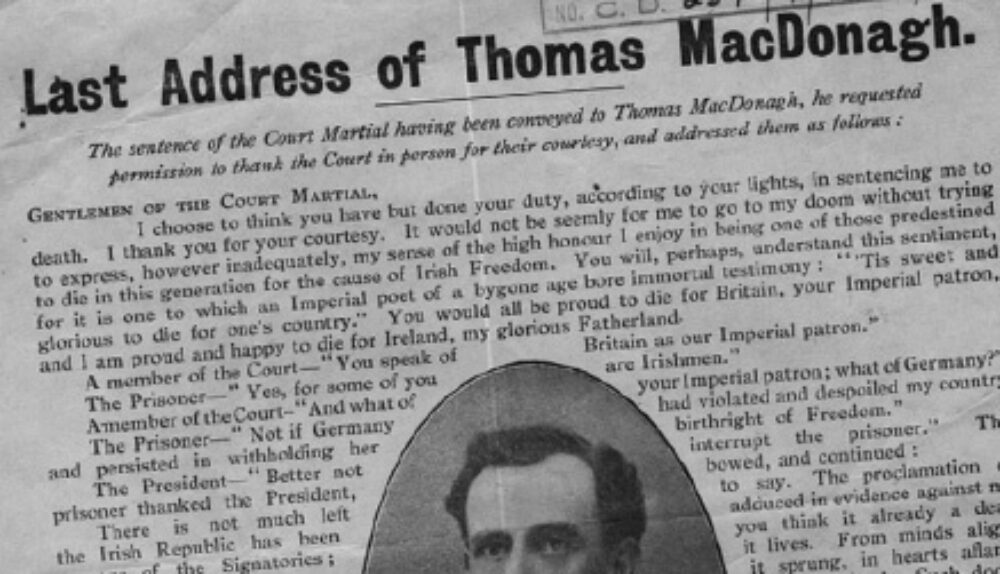Themes: Executions Sub-themes: Executions
Subject: History
Estimated No. of Classes: 2
Toolkit: Projector, Internet Connection, Computer Lab, Print Outs
Funders: The Department of Education and Skills and the Irish Research Council.
Developed by: The Letters of 1916 Project, The Military Archives, An Foras Feasa and The Humanities Institute at Maynooth University.
Download: Download
Back
"Some must suffer for their crimes"
Abstract:
This lesson plan gives students scope to focus on the experience and fate of sixteen leaders who were imprisoned, court martialled and executed as a consequence of their part in the 1916 Rising. The lesson aims to teach students how to locate and engage with online primary sources for research purposes, and to use digitised material in a discerning way. The lesson will familiarise students with a range of websites which will enable students to examine digitised primary sources. The students should filter their search results, research independently and report back their findings to the class about the experience and outcome for key participants of the 1916 Rising. The sources also allude to the experience of family members and clergy who visited the men in their final hours.
Lesson Aims/Objectives:
a. To engage students in the analysis of primary source material
b. To familiarise students with sites to aid their research in this area including the Military Archives, Letters of 1916 and Dictionary of Irish Biography (see Materials Needed section ‘a’)
c. To equip students with a better understanding of the immediate aftermath of the 1916 Easter Rising and the outcome for participants of the 1916 Easter Rising
Advanced Preparation Required:
a. Teachers should ensure that militaryarchives.ie, Letters 1916 and https://www.dib.ie/ are whitelisted (see Materials Needed section ‘a’).
b. If computer facilities are not available, it is possible to teach a pared down version of the lesson, focusing on one or two of the leaders and using printed sources (see Materials Needed section ‘c’ below)
c. Teacher should ensure that students have a good understanding of the events during Easter week 1916. This lesson would work best as part of a series of lessons exploring the 1916 Rising.
Methodology:
a. To provide context, the teacher should explain the collapse of the 1916 Easter Rising by focusing on the collapse of General Headquarters and the evacuation of the GPO (see Materials Needed section ‘b’).
b. The teacher should instruct students on how to navigate and search the Letters 1916 and Military Archives sites (see Materials Needed section ‘a’) on the projector if students are to research using online resources. The teacher should advise students to search using a number of keywords when using the militaryarchives.ie site and advise students to search variables of spelling in some personal names (i.e. Padraig and Patrick Pearse, MacDiarmada/McDermott) - this is an excellent opportunity to highlight one of the challenges faced when using primary sources. Results are likely to be multiple and wide reaching in terms of subject matter; part of the research task for students is to filter results and speed read to determine which statements/pension records will be of most use when plotting the final hours of the executed men.
c. The Teacher should determine whether lesson will involve the participation of groups or individual students and whether the tasks will be completed inside or outside class time. The teacher may choose groups or individuals to explore particular leaders or may leave it to students to decide which individual they would like to focus on, offering a brief biographical sketch of the sixteen executed leaders. Access to the Dictionary of Irish Biography will assist with this task (see Materials Needed section ‘a. iv’).
d. In the following class students will make individual 1-2 minute presentations or 5-7 minute group presentation on their selected individual and how they chose the relevant information from the sites/sources.
Assessment:
a. Teacher can informally assess student ability to access and use relevant resources during the course of the lesson
b. Assessment of the student/group presentations, eg. delivery, accuracy and relevance of content
c. The selection of relevant material and its appropriate use can be assessed either through the presentations, or through teacher questioning.
Materials Needed:
a. Websites:
i.www.militaryarchives.ie to locate Bureau of Military History witness statements once a student/group have reached a decision about the leader that they would like to focus on. Please note that the Voice Recordings/Audio options on this site could also prove useful for students so headphones may be needed.
ii.www.militaryarchives.ie to locate military service pension application records using search terms
iii.Letters of 1916 This section contains last letters before death.
iv.Dictionary of Irish Biography
b. Contextualisation:
ii.Sinn Fein Rebellion handbook
contains useful background to the events leading up to the surrender of the Leaders and execution.
c. Resources for Student Use:
i. Images of some leaders CD/227/3/11
ii.Letters of 1916
This section contains last letters before death.
iii.Witness Statement of Father Aloysius, Chaplain to some of the leaders, WS 200 (pp.9-18)
iv. Copy of Pearse letter to his mother, 3 May 1916.
BMH/CD/062/03/1
v. Manuscript and printed version of Last address made by Thomas MacDonagh following his court martial
BMH CD/227/03/02
BMH CD 257/01/01
vi. Letter from Seán Heuston to E. Walshe, 7 May 1916
BMH CD/095/2/4
vii. Typed copy of statement written by Rev. Father J.M Heuston shortly after Easter week 1916.
BMH CD 309/01
vii. Notes made by 2 Lieutenant R.C. Barton, 10th Royal Dublin Fusiliers about May/June 1916 regarding the execution of leaders, and particularly
James Connolly
BMH CD/264/01/03
viii. Witness statement of Robert C. Barton. WS 979 (pp.4-7) regarding execution of
James Connolly
BMH.WS0979.pdf
ix. Witness statement of Ina Heron, daughter of James Connolly. WS 919 (pp.103-105)
BMH.WS0919.pdf
x. Witness statement of Nora Connolly O’Brien, daughter of James Connolly. WS 286 (pp.48-55)
BMH.WS0286.pdf
xi. Letter 2 August 1916 from Father E.F. Murnane to George Gavan Duffy describing his last interview with Casement
BMH CD/045/02/28
xii. Copy letter, 25 July 1916 from Roger Casement to his sister Nina shortly beforehis execution
BMH CD/045/02/24

